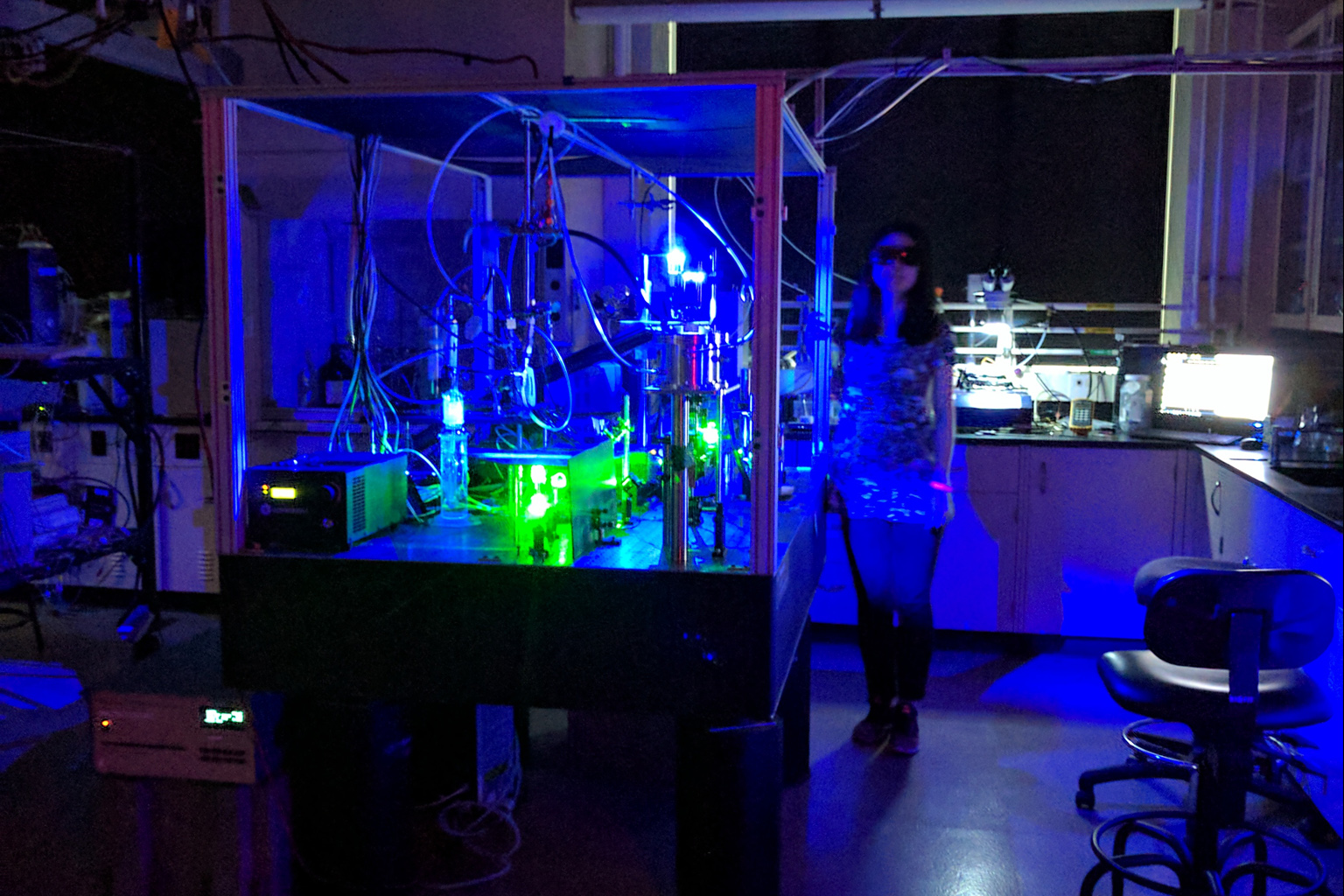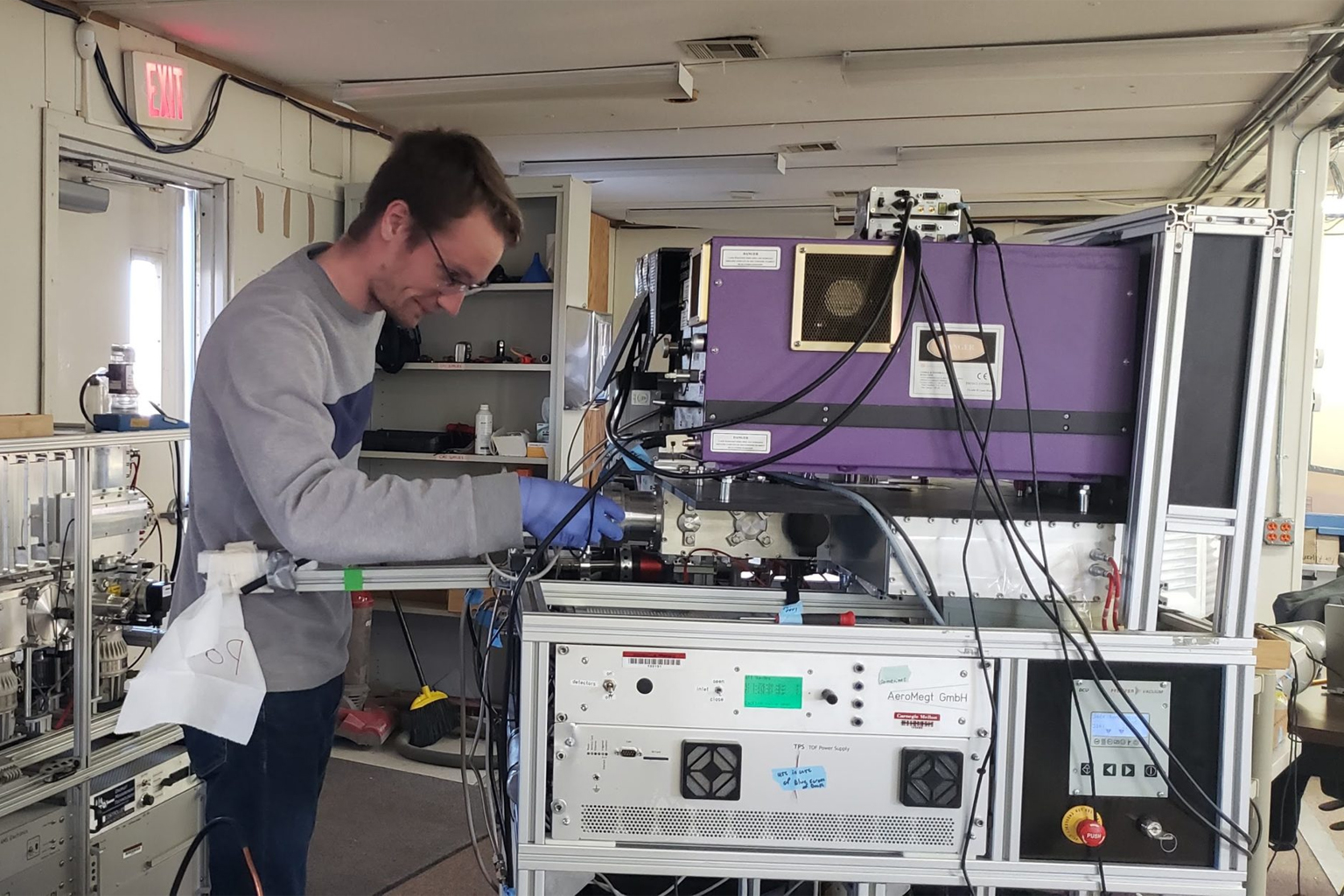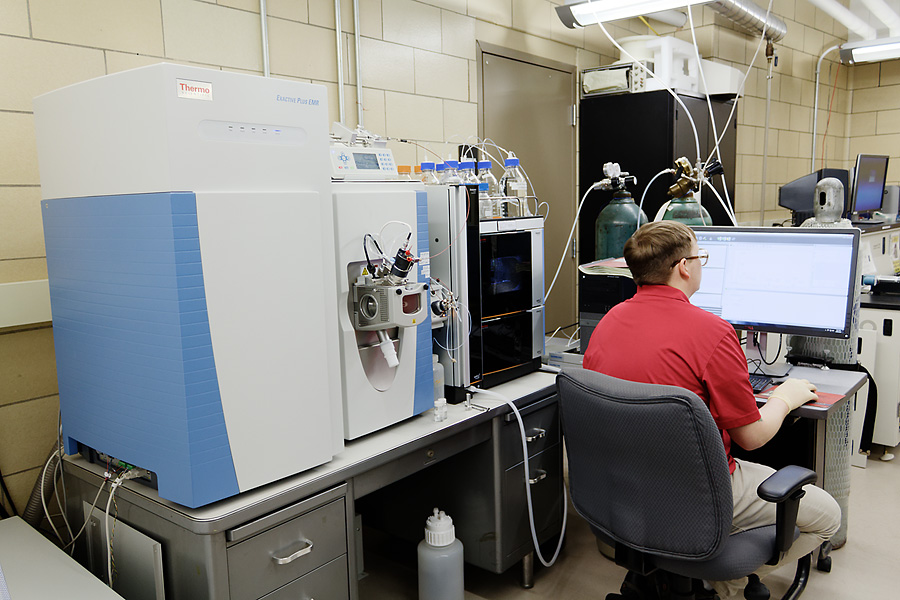Instrumentation
The Sullivan group develops and advances novel instrumentation with a focus on single-particle analysis techniques. We also benefit from having full access to the extensive instrumentation and facilities available in the Center for Atmospheric Particles Studies’ (CAPS) Air Quality Laboratory, including a suite of mass spectrometers and smog chamber reactors. We regularly use instrumentation available such as liquid chromatography mass spectrometers (LC-MS) in shared facilities such as the Center for Molecular Analysis in the Department of Chemistry, and in the Environmental Engineering Water Analysis Laboratory, and SEM/TEM electron microscopes in the Central Electron Microscope facility. We actively collaborate with and use the resources available in the Institute for Green Science and the Center for Complex Fluids Engineering. We are working on interfacing mass spectrometry with our custom aerosol optical tweezers systems and microfluidic lab-on-a-chip devices to enable molecular-level characterization of microdroplets levitated in light or contained in a microchannel.

Aerosol Mass Spectrometer (AMS)
Two Aerodyne high-resolution time-of-flight aerosol mass spectrometers (AMS) are available in CAPS. One has a light scattering module (LS-AMS) to trigger single-particle measurements. Another has an intracavity IR laser to vaporize black carbon soot particles (SP-AMS) and can acquire single-particle level measurements using event triggering. The AMS provides size and chemical composition measurements of submicron non-refractory aerosol particle components that evaporate at 600 C. Refractory black carbon is also measured using IR laser vaporization in the SP-AMS and it is therefore used in all of our biomass-burning aerosol experiments and many of our field experiments.
Aerosol Optical Tweezers (AOT)
The aerosol optical tweezers (AOT) custom-built experimental platforms designed by the Sullivan group for stable trapping of liquid droplets and crystallized particles levitated in air by laser light. The main components are the 532 nm laser, microscope objective, custom-designed trapping chamber, Raman spectrometer, and a variety of nebulizers to generate aerosols to be trapped. A single dielectric aerosol particle becomes tweezed just past the focal point of the laser beam – where the electric field is strongest – through a balance of scattering and gradient forces. Inelastically scattered Stokes-shifted photons are collected through the same microscope objective and analyzed by a Raman spectrometer. The AOT enables high-accuracy real-time analysis of both aerosol physical and chemical properties and how these evolve during simulated atmospheric chemistry experiments with exposure to trace gases or coagulation of other aerosol particle material. These measurements are obtained both from the molecular vibrational modes inherent to the spontaneous Raman spectrum, and by analyzing the stimulated whispering gallery modes (WGMs) that arise when light undergoes total internal reflection around the circumference of the symmetric droplet. These WGMs provide high-accuracy measurements of particle size, refractive index, phase-separated morphology, and chemical composition. We have developed the ability to perform highly accurate pH measurements of tweezed pL droplets from the Raman spectra and WGM analysis, and we advanced the WGM analysis algorithm that retrieves the properties of both the core and shell phases in biphasic droplets. A specially-designed temperature-controlled chamber capable of performing AOT experiments on droplets stably tweezed at subzero temperatures and above ice vapor saturation has also been developed to enable studies of supercooled aqueous droplets and heterogeneous ice nucleation processes.



Laser Ablation Aerosol Particle Time of Flight Mass Spectrometer (LAAPTOF)
The laser ablation aerosol particle time of flight (LAAPTOF) mass spectrometer obtains real-time measurements of the size and chemical composition of individual aerosol particles. Aerosol particles enter through an aerodynamic inlet that focuses and concentrates the particles into a narrow beam that passes through two violet light scattering lasers. The scattered laser light is used to detect and determine the velocity and vacuum aerodynamic diameter of each particle. This also triggers the excimer laser pulse that ablates each particle and ionizes the resulting molecular vapors. The bipolar time-of-flight mass spectrometer obtains the positive and negative ion mass spectra from each particle that contain complementary information regarding the source of each particle and the chemical processes each has experienced during atmospheric transport. The LAAPTOF is routinely used in our laboratory and field experiments to understand how the initial composition of each particle influences its further chemical reactivity and evolution, and to identify particle sources and unique particles such as the rare ice nucleating particles.
Time of Flight Chemical Ionization Mass Spectrometer (TOF-CIMS)
An Aerodyne high-resolution time-of-flight chemical ionization mass spectrometer is available in the CAPS laboratories. Chemical ionization is a soft and selective ionization technique, allowing for minimal fragmentation of gas-phase analytes and high sensitivity. Coupling this ionization to a high-resolution time-of-flight mass spectrometer allows us to resolve chemical species with the same nominal masses but different exact masses, enabling determination of the molecular formula for most analytes that are ionized by the selected reagent ion. The other advantage of the TOF-CIMS is its ability to perform real-time online measurements, making it ideal for systems where chemical reactions and processes are occurring quickly on the timescales of seconds-minutes. Finally, the TOF-CIMS also has a Filter Inlet for Gases and AEROsols (FIGAERO) that enables the separate measurement of species in the gas and particle phases via CIMS. We use the TOF-CIMS to explore the emissions and chemistry of combustion processes such as biomass-burning aerosol with a focus on understanding heterogeneous chemical reactions between nitrogen oxides, halogens, and organic carbon components.


Exactive Plus EMR Orbitrap Mass Spectrometer
When truly high mass resolving power (up to 140,000) and mass accuracy is required for our molecular-level analysis, we utilize the Exactive Plus EMR Orbitrap mass spectrometer in the Center for Molecular Analysis. This instrument uses a novel mass analyzer to both separate and detect ions based on their resonant frequency in a uniform magnetic field. Samples can be introduced to the Orbitrap mass spectrometer directly, via ultrahigh performance liquid chromatography (UPLC), or via a Direct Analysis in Real Time (DART) ionization source. UPLC allows for additional chemical information through chromatographic separation based on polarity or molecular size to be obtained prior to mass spectrometric analysis, while DART allows for ionization directly from surfaces and substrates. We frequently use the Orbitrap for offline chemical analysis of combustion emissions and identification of transformation products from chemical remediation methods we are developing for persistent contaminants.
Microfluidics
We collaborate with Professor Shelley Anna’s group, part of Carnegie Mellon’s Center for Complex Fluids Engineering, to design and create microfluidic devices for the manipulation of analysis of aqueous microdroplets suspended in oil. Currently, our group has utilized flow focusing and “store and create” chip geometries to generate arrays of >500 microdroplets containing particles of interest. We analyze these droplet arrays to explore the ice nucleation activity of biological particles, mineral dusts, ambient aerosol, and biomass-combustion aerosol. In this novel technique droplets are produced and are stored on chip within a microfluidic device, each isolated in its own microwell. The microfluidic device is placed onto a cold plate and subjected to a cooling cycle while the droplets are tracked visually using microscopy to detect at what temperature each droplet freezes. Using our own developed Matlab algorithm we can accurately retrieve the droplet freezing temperature spectrum from an array of 600 droplets of just 6 nL in volume and 150 microns in diameter.
